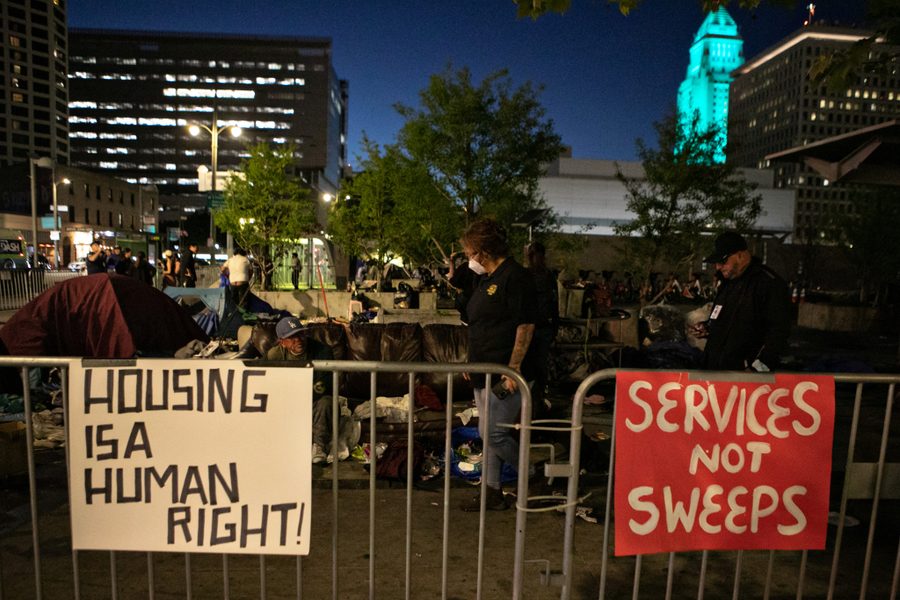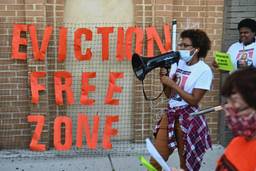Voters Could Help Stem the Homelessness Crisis in L.A. Next Month
A sweeping ballot initiative dubbed the “mansion tax” would raise funds to build supportive housing, provide rental assistance and implement other measures to help curb the crisis facing unhoused Los Angeles residents.
Annie Howard

After increasing nearly 25% between 2018 and 2020, the homeless population in the Los Angeles area has grown more slowly over the past two years. According to the latest count from the Los Angeles Homeless Services Authority, L.A. County’s unhoused population grew from 66,436 in 2020 to 69,144 in 2022, an increase of 4.1%. While there are numerous reasons for this downtrend, government intervention has played an important role. Such measures as Project Roomkey, which used federal, state and local funds to keep more than 10,000 residents in hotels and motels during the Covid-19 pandemic, showed that even modest public programs can make a significant impact on the city’s housing crisis, even as the initiative’s remaining residents lost their housing at the end of September.
But a slowdown in the overall growth of the city’s unhoused population betrays deeper reasons for concern. Particularly troubling is recent research by Home For Good – Los Angeles County, which found that older adults are the area’s fastest-growing homeless population, with 75% of seniors who live in rental units experiencing “rent burden” — spending 30 – 50% of their income toward rent. Senior homelessness is also a matter of racial inequality: while just 8% of LA County’s population is Black, 39% of seniors experiencing homelessness are Black, compared with 33% of the general homeless population.
For Laura Raymond, director of Alliance for Community Transit, a coalition of organizations fighting for equitable transit, housing, environmental justice and public health, this spike in senior housing instability is among her biggest concerns. It’s also one of the key reasons her organization has joined the fight for United to House LA, a campaign that’s been endorsed by housing advocates, homeless service providers and labor unions across the city. Measure ULA, as the initiative will appear before Los Angeles voters during November’s election, could raise nearly $1 billion in annual revenue to address L.A.’s housing crisis, with funds specifically geared toward older residents struggling just to stay sheltered.
“We’re on track to triple senior homeless if we don’t have an intervention soon,” Raymond says. “Seniors getting direct financial assistance if they’re facing homelessness is one thing that we’re trying to educate voters about, because having our seniors be so housing insecure is heartbreaking.”
Measure ULA’s proposal is sweeping and straightforward: by placing a 4% tax on real estate transfers of properties valued at $5 million or more, and a 5.5% tax on transfers above $10 million, the city could raise more than $900 million annually, according to research from UCLA’s Lewis Center for Regional Policy Studies. Taxing both commercial and residential housing sales, the measure would only impact about 4% of all transactions, with almost zero impact on everyday Angelenos. The proposal has led some commentators to dub it the “mansion tax.” The measure’s populist appeal, and its clear targeting of millionaire and billionaire wealth to address local housing challenges, has made the measure popular in doorknocking conversations with voters — more than 98,000 signatures were gathered, far more than the 61,076 required to get on the ballot.
“One thing that people do agree on is that there’s not enough housing, particularly not enough housing [that] is affordable to low-income people,” says Cynthia Strathmann, executive director for Strategic Actions for a Just Economy (SAJE), which advocates for tenant protections and equitable development. “There’s actually quite a bit of market-rate housing that’s been built in Los Angeles, and we’ve met our regional housing needs assessment goals for higher-end housing, but for the low-cost housing that is available, there’s a lot of competition for it.”
The increased revenue from the measure’s progressive taxation would go toward a mix of approaches to stem the housing crisis. In addition to funding the construction of permanent supportive housing (proponents estimate that 26,000 units of new housing could be funded over the next 10 years), it would also support legal aid for renters in eviction court, rapid rehousing for those in need of shelter, and rental assistance for seniors on the brink of homelessness. This mix of approaches, proponents argue, is critical to addressing the many forces driving the housing crisis in a city whose rents are among the highest in the country. And by keeping people in their homes in the first place, the city can ultimately save money while minimizing harmful disruptions to people’s lives.
Given its straightforward approach, ULA’s opponents are resorting to a misleading information campaign intended to scare voters, describing the measure as Los Angeles’ largest-ever property tax increase. But thanks to Proposition 13, a 1978 statewide ballot measure that capped property taxes at 1% of a property’s purchase rate, such tax increases remain illegal statewide, with ULA’s proposed tax only coming into effect at the time of a property’s sale. Deep-pocketed real estate interests, such as the California Business Roundtable, are helping fund this campaign to maintain a broken status quo, while the Measure ULA campaign hopes to offer a genuine solution to the city’s needs.
In order to pass, the measure will require more than 50% public support. It has been endorsed by the Los Angeles Times, multiple unions (including United Teachers of Los Angeles), and various movement groups (including Sunrise Movement Los Angeles and the Los Angeles Chapter of the Democratic Socialists of America). While no public polling is available, proponents are confident that once voters see the measure on their ballots, they’ll get behind it.
“[Measure ULA] was initiated by nonprofits and activists, not by politicians or by business interests, and because of that, it’s going to be a fight of less resourced people against highly resourced people,” Cynthia Strathmann says. “Los Angeles has an unsavory history of redlining and discriminatory housing policies, and those people are still out there trying to avoid finding solutions.”
Annie Howard is a freelance organizer and organizer with the Chicago Housing Justice League. She’s on Twitter @t_annie_howard.


